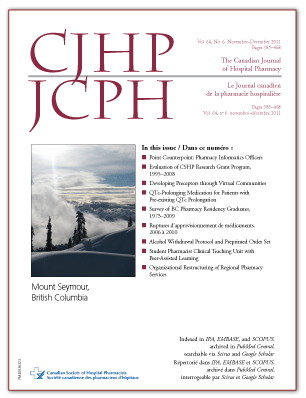Evaluation of an Alcohol Withdrawal Protocol and a Preprinted Order Set at a Tertiary Care Hospital
DOI:
https://doi.org/10.4212/cjhp.v64i6.1085Keywords:
alcohol withdrawal protocol, Clinical Institute Withdrawal Assessment for Alcohol, revised, symptom-triggered therapy, fixed-schedule therapy, benzodiazepine, protocole de sevrage alcoolique, révisée,Abstract
ABSTRACT
Background: Alcohol withdrawal protocols involving symptom-triggered administration of benzodiazepine have been established to reduce the duration of treatment and the cumulative benzodiazepine dose (relative to usual care). However, the effects of a protocol combining fixed-schedule and symptom-triggered benzodiazepine dosing are less clear.
Objective: To assess the efficacy and safety of a combination fixedscheduled and symptom-triggered benzodiazepine dosing protocol for alcohol withdrawal, relative to usual care, for medical inpatients at a tertiary care hospital.
Methods: A chart review of admissions to the internal medicine service for alcohol withdrawal was conducted to compare treatment outcomes before (October 2005 to April 2007) and after (October 2007 to April 2009) implementation of the combination protocol. The primary outcome was duration of benzodiazepine treatment for alcohol withdrawal. The secondary outcomes were cumulative benzodiazepine dose administered, safety implications, and use of adjunctive medications.
Results: A total of 159 patients met the inclusion criteria. Assessable data were available for 71 charts from the pre-implementation period and 72 charts from the post-implementation period. The median duration of benzodiazepine treatment was 91 h before implementation and 57 h after implementation (p < 0.001). Use of the protocol was also associated with a significant reduction in severe complications of alcohol withdrawal (50% versus 33%, p = 0.019), median cumulative benzodiazepine dose (in lorazepam equivalents) (20.0 mg versus 15.5 mg, p = 0.026), and use of adjunctive medications (65% versus 38%, p = 0.001). The incidence of serious adverse outcomes of treatment with benzodiazepines was not significantly different between the 2 groups.
Conclusions: Implementation of an alcohol withdrawal protocol with a combination of fixed-schedule and symptom-triggered enzodiazepine dosing in a medical ward was associated with a shorter duration of benzodiazepine use and a lower incidence of severe complications of alcohol withdrawal.
RÉSUMÉ
Contexte : Les protocoles de sevrage alcoolique impliquant l’administration de benzodiazépine adaptée à la symptomatologie ont été mis en place pour réduire la durée du traitement et la dose cumulative de benzodiazépine (par comparaison aux soins habituels). Cependant, les effets d’un protocole combinant l’administration de benzodiazépines à horaire fixe et adaptée à la symptomatologie sont moins clairs.
Objectif : Évaluer l’efficacité et l’innocuité d’un protocole de sevrage alcoolique combinant l’administration de benzodiazépines à horaire fixe et adaptée à la symptomatologie, par comparaison aux soins habituels, chez des patients hospitalisés dans un service médical d’un hôpital de soins tertiaires.
Méthodes: Une analyse des dossiers médicaux des patients hospitalisés dans un service de médecine interne pour un sevrage alcoolique a été effectuée afin de comparer les résultats du traitement avant (entre octobre 2005 et avril 2007) et après (octobre 2007 à avril 2009) la mise en oeuvre du protocole mixte. Le principal paramètre d’évaluation était la durée du traitement par les benzodiazépines pour le sevrage alcoolique. Les paramètres d’évaluation secondaires étaient la dose cumulative de benzodiazépines administrée, les répercussions sur l’innocuité et le recours à des médicaments d’appoint.
Résultats : Un total de 159 patients ont satisfait aux critères d’inclusion. Des données évaluables étaient disponibles pour 71 dossiers médicaux dans la période précédant la mise en oeuvre du protocole et pour 72 dossiers médicaux dans la période suivant la mise en oeuvre du protocole. La durée médiane du traitement par les benzodiazépines pour chaque période ci-dessus était de 91 et 57 heures, respectivement (p < 0.001). L’utilisation de ce protocole a également été associée à une réduction significative des complications graves du sevrage alcoolique (50 % contre 33 %; p = 0,019), de la dose cumulative médiane de benzodiazépines (en équivalent-lorazépam) (20,0 mg contre 15,5 mg, p = 0,026) et du recours à un médicament d’appoint (65 % contre 38 %, p = 0,001). La fréquence des conséquences indésirables sérieuses du traitement par les benzodiazépines n’était pas significativement différente entre les deux groupes.
Conclusions : La mise en oeuvre d’un protocole de sevrage alcoolique combinant l’administration de benzodiazépines à horaire fixe et adaptée à la symptomatologie dans un service médical a été associée à un traitement par les benzodiazépines plus court et à une fréquence moindre des complications sérieuses du sevrage alcoolique.
Downloads
Published
Issue
Section
License
Copyright © Canadian Society of Healthcare-Systems Pharmacy.
After publication of a manuscript in the CJHP, the authors of the manuscript must obtain written permission from the CSHP (publications@cshp.ca) before reproducing any text, figures, tables, or illustrations from the work in future works of their own. If a submitted manuscript is declined for publication in the CJHP, all said rights shall revert to the authors. Please note that any forms (e.g., preprinted orders and patient intake forms) used by a specific hospital or other health care facility and included as illustrative material with a manuscript are exempt from this copyright transfer. The CJHP will require a letter from the hospital or health care facility granting permission to publish the document(s).










